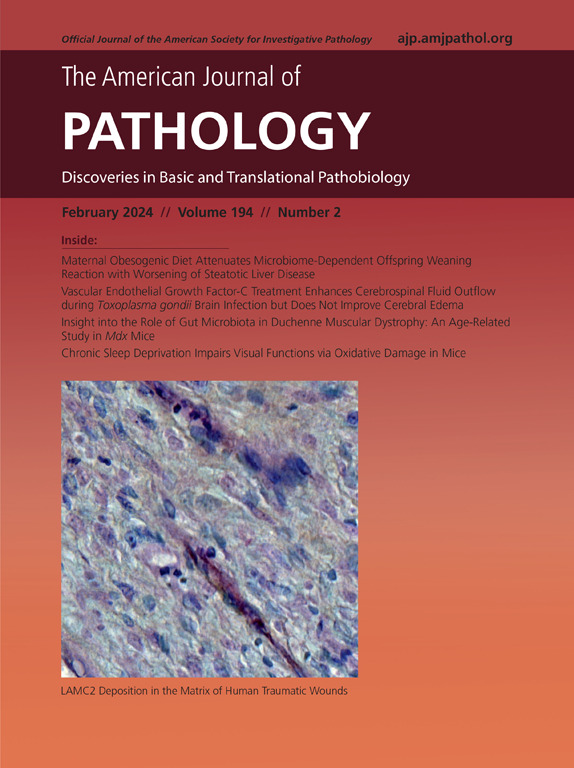Exploratory Study of Prognostic Plasma Biomarkers in Patients with Pulmonary Arterial Hypertension
IF 3.6
2区 医学
Q1 PATHOLOGY
引用次数: 0
Abstract
Pulmonary arterial hypertension (PAH) is characterized by progressive pulmonary vascular lumen occlusion, ultimately leading to right ventricular failure and death. Risk stratification is essential for the management of patients with PAH. So far, B-type natriuretic peptide and its N-terminal pro-form are the only circulating biomarkers used as part of composite PAH risk assessment tools. Identification of other biomarkers of vascular or systemic origin may be valuable to provide additional information on disease severity and prognosis. Using proximity extension assay, >700 proteins related to oncology and neurology were measured in the plasma of 60 patients with PAH and 28 age- and sex-matched controls. Among the 114 proteins significantly up-regulated in patients with PAH, 14 were independently associated with death/lung transplantation after adjustment for the 2015 European Society of Cardiology/European Respiratory Society, the Registry to Evaluate Early and Long-Term PAH Disease Management (REVEAL) 2.0 risk scores, and the refined four-stratum risk assessment model. Among them, ectodysplasin A2 receptor (EDA2R), WAP four-disulfide core domain 2 (WFDC2), and tumor necrosis factor receptor superfamily member 10B (TNFRSF10B) displayed incremental prognostic value on top of these predictive models. Combining previously published proteomic data sets generated from different panels with the same cohort, a set of 23 proteins was identified, many of which are strongly associated with chronological age, that predict outcome of patients with PAH after adjusting for risk assessment tools. In conclusion, proteins likely involved in the pathophysiology of the disease and potential candidates for prognostic enrichment were identified in this study.
肺动脉高压患者预后血浆生物标志物的探索性研究。
肺动脉高压(PAH)以进行性肺血管腔闭塞为特征,最终导致右心室衰竭和死亡。风险分层对PAH患者的管理至关重要。到目前为止,b型利钠肽及其n端前体是唯一被用作复合多环芳烃风险评估工具的循环生物标志物。血管或全身起源的其他生物标志物的鉴定对于提供疾病严重程度和预后的额外信息也很有价值。采用接近延伸法,在60例PAH患者和28例年龄和性别匹配的对照组中测量了700多种与肿瘤和神经学相关的蛋白质。经2015年ESC/ERS、REVEAL 2.0风险评分和改进的4层风险评估模型调整后,在PAH患者中发现的114种蛋白显著上调,其中14种与死亡/肺移植独立相关。其中EDA2R、WFDC2和TNFRSF10B在这些预测模型的基础上表现出递增的预后价值。结合我们之前发表的来自同一队列的不同小组的蛋白质组学数据集,确定了一组23个蛋白质,其中许多与实足年龄密切相关,可以预测PAH患者在调整风险评估工具后的预后。总之,我们确定了可能参与疾病病理生理的蛋白质和潜在的预后富集候选蛋白。
本文章由计算机程序翻译,如有差异,请以英文原文为准。
求助全文
约1分钟内获得全文
求助全文
来源期刊
CiteScore
11.40
自引率
0.00%
发文量
178
审稿时长
30 days
期刊介绍:
The American Journal of Pathology, official journal of the American Society for Investigative Pathology, published by Elsevier, Inc., seeks high-quality original research reports, reviews, and commentaries related to the molecular and cellular basis of disease. The editors will consider basic, translational, and clinical investigations that directly address mechanisms of pathogenesis or provide a foundation for future mechanistic inquiries. Examples of such foundational investigations include data mining, identification of biomarkers, molecular pathology, and discovery research. Foundational studies that incorporate deep learning and artificial intelligence are also welcome. High priority is given to studies of human disease and relevant experimental models using molecular, cellular, and organismal approaches.

 求助内容:
求助内容: 应助结果提醒方式:
应助结果提醒方式:


